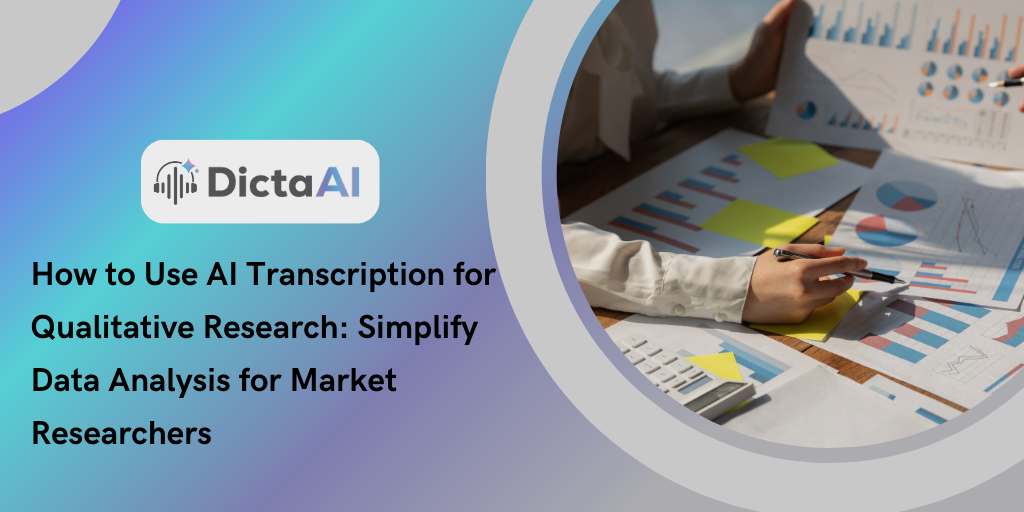
Qualitative research is all about digging into the “why” behind people’s thoughts, behaviors, and experiences. Whether you’re running in-depth interviews, hosting focus groups, or conducting ethnographic studies, you’re collecting a ton of rich, nuanced data. But let’s face it—spending hours rewinding audio and straining to catch every single word is exhausting.
That’s where AI transcription services steps in and saves the day. With just a few clicks, you can get accurate transcripts in minutes instead of slogging through them manually. And it’s not just about convenience—once you have those transcripts, it’s much easier to spot themes, patterns, and those all-important key moments.
AI transcription automatically converts audio or video recordings into text—no more struggling to catch every word on your own. These tools are trained to handle a wide range of accents, speech patterns, and even multiple speakers at once, making them ideal for qualitative research like interviews or focus groups. Because AI can tackle the trickiest speech challenges, you can skip the manual drudgery and dive straight into insights.
For qualitative researchers, features like speaker identification and timestamping add even more convenience, helping you sort through data faster. The result? Less time on transcription, more time on analysis.
AI transcription can transform hours of recordings into text in just minutes, so you can move on to analysis faster.
Affordable transcription services means you don’t have to hire expensive manual transcribers, leaving more room in your budget for other critical research needs.
Many AI transcription tools are user-friendly and integrate seamlessly into your existing workflow—no steep learning curve required.
AI transcription is a true asset in market research, offering flexible formats for different needs. For instance, verbatim transcription captures every spoken word, including pauses, fillers, and emotional nuances—giving you a clearer view of consumer sentiment.
On the other hand, intelligent editing removes unnecessary words and distractions while keeping the core message intact, making it simpler to pinpoint the most relevant insights. Whether you need ultra-detailed transcripts or a quick overview, AI transcription services helps you focus on what really matters in your data.
Say goodbye to manual bottlenecks and hello to more time for strategy and deep-dive analysis.
From one-on-one interviews to massive focus groups, AI transcription adapts to projects of any size.
Free yourself from the cost of manual transcription and invest those funds in other important aspects of your research.
AI can process accents, technical jargon, and nuanced speech with ease—especially if you add a human review step for extra precision.
Advanced AI features let you quickly spot key themes, gauge emotional tone, and create concise overviews of your findings.
AI is impressively accurate, but a quick human pass ensures tricky details are captured, especially for complex or specialized data.
Look for platforms that comply with privacy rules like GDPR or HIPAA. If you handle sensitive info, choose tools with built-in PII redaction features.
If you need every “um” and pause for detailed qualitative analysis, go for verbatim transcripts. If you want quick reports, intelligent editing keeps things streamlined without losing key insights.
By following these simple guidelines, you’ll strike the perfect balance between speed, accuracy, and data protection—ensuring you reap the full benefits of AI transcription.
AI transcription is a powerful tool, but researchers sometimes face challenges that call for a more advanced approach. Here’s how DictaAI tackles those hurdles:
AI tools can stumble over specialized terminology, especially in industries like medicine, law, or engineering. That’s why DictaAI combines human expertise with cutting-edge AI. Our Human + AI hybrid approach fine-tunes transcriptions to handle all your industry-specific language with ease.
Quality audio leads to accurate transcripts. Whenever possible, use professional-grade microphones, record in quiet areas, and minimize background noise. If your audio isn’t perfect, DictaAI’s dual-layer method—a combo of AI-driven transcription and human review—makes sure no critical details slip through the cracks.
AI transcription services has quickly become an essential tool for modern qualitative research. By automating the transcription process, you can cut down on time-consuming tasks and focus on what matters most—uncovering valuable insights and making data-driven decisions.
Ready to speed up your qualitative research and gain deeper insights into your market? Try DictaAI for seamless, high-accuracy transcription. Contact us to learn more about our plans and see how we can supercharge your research process.
Comments
Glynnis Campbell
This is a test comment!